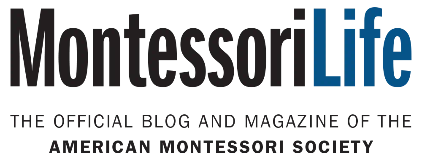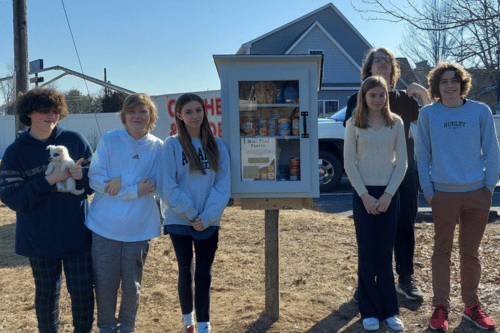Over thirty-eight million people in the United States experience food insecurity. Of those people, 29% do not qualify for federal nutrition programs. The Little Free Pantry is a grassroots movement that activates neighbor engagement with food insecurity. The group is composed of community members who “see [their] neighbors’ daily struggles and feel called to do something in a way that reflects [their] shared values—compassion, generosity, and trust.” Their goal is to make change from the bottom up, focusing on the interdependence of neighbors and communities who mutually benefit from the process of creating something big from something “little.”
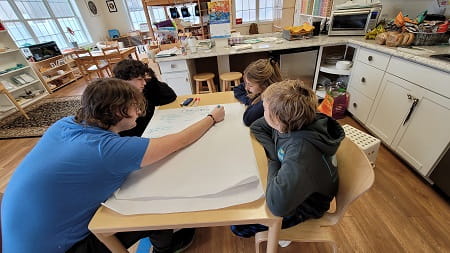 Gathered by Samantha Sweet, Elementary assistant at the AMS-accredited school, Children’s Tree Montessori, a group of adolescent volunteers in Old Saybrook, CT made it their mission to implement these same changes in their community. Through a series of activities and investigations led by Samantha (project coordinator), the team gained a deeper understanding of food insecurity, realizing that, as members of a relatively affluent and semi-rural area, those who might be struggling in their community may not be as recognizable.
Gathered by Samantha Sweet, Elementary assistant at the AMS-accredited school, Children’s Tree Montessori, a group of adolescent volunteers in Old Saybrook, CT made it their mission to implement these same changes in their community. Through a series of activities and investigations led by Samantha (project coordinator), the team gained a deeper understanding of food insecurity, realizing that, as members of a relatively affluent and semi-rural area, those who might be struggling in their community may not be as recognizable.
Sweet reveals although it might not be readily apparent to those in the community, “according to feedingamerica.org, the food insecurity rate in Connecticut is 10.5% and 8.8% in Middlesex County, where the team resides. That is over 14,000 individuals who are struggling with food security.” With a spike in population in recent years as new residents have entered the community from nearby larger cities, Sweet assumes this number has experienced an even greater increase. Add to that the fact that the cost of housing in Old Saybrook has skyrocketed, and Sweet notes that the number of those struggling with food security may be higher than it has ever been in their area.
One student shares what it was like to learn that some of their fellow community members were struggling, stating, “we had studied food insecurity and we learned how there are many people who do not know where their next meal is coming from who we never see.” Another student mentioned, “it was sad to learn that there are people who desperately need help.”
Surprised to see just how many of their neighbors might be struggling in this area, these six students joined together to make a plan of how to help those in need.
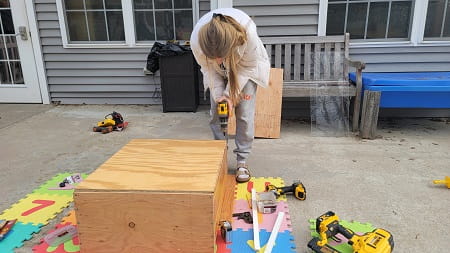 Inspired by a TedTalk showcasing an adolescent who constructed and managed their own Little Free Pantry, the group decided that building their own mini pantry was a feasible way for them to begin giving back. Based on an initial conversation about the stigma that exists for those who are struggling in Old Saybrook, the team felt the pantry was a great solution to provide food for those in need without citizens needing to experience the shame or embarrassment that might come into direct contact with others from the community.
Inspired by a TedTalk showcasing an adolescent who constructed and managed their own Little Free Pantry, the group decided that building their own mini pantry was a feasible way for them to begin giving back. Based on an initial conversation about the stigma that exists for those who are struggling in Old Saybrook, the team felt the pantry was a great solution to provide food for those in need without citizens needing to experience the shame or embarrassment that might come into direct contact with others from the community.
Two of the girls partnered together to form the construction team. They found most of the necessary materials in a workshop the school owns and asked for donations from local businesses for paint and a post. The rest of the construction supplies were recycled or reused materials. Another group of students focused on researching the legal steps required to install a pantry on the school’s campus, while a third concentrated on marketing strategies and campaigns. The marketing team crafted a letter to send to families in the community asking for food donations.
A construction expert came in to help the students with the construction. He provided tips and answered a lot of their questions. Another volunteer from the community who has had a Little Free Pantry at their business for five years also came to share valuable insight with the group, answering their questions and addressing their concerns about the pantry.
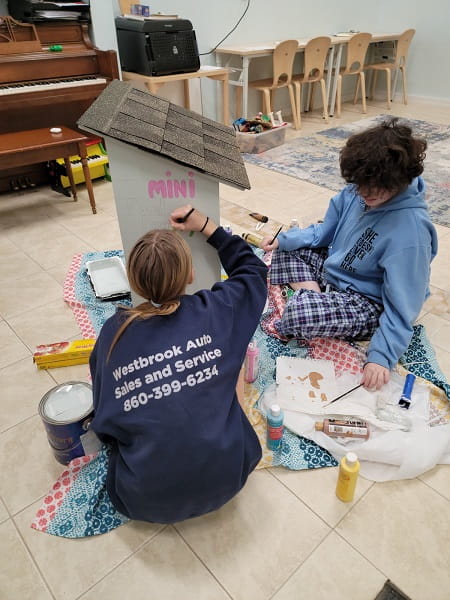 Despite not knowing one another, this group of adolescents worked together cohesively from the very beginning. As Samantha says, “They were all there for a purpose, to serve those in our community who are struggling… They relied on one another for decisions, physical strength, artistic insight, and peer reviews.” The project also fostered independence and perseverance as the children contacted local businesses to ask for donations and hang fliers. Even for those group members who found this type of communication challenging, Samantha notes that the intrinsic reward was plentiful as they received that “valorization that adolescents crave.”
Despite not knowing one another, this group of adolescents worked together cohesively from the very beginning. As Samantha says, “They were all there for a purpose, to serve those in our community who are struggling… They relied on one another for decisions, physical strength, artistic insight, and peer reviews.” The project also fostered independence and perseverance as the children contacted local businesses to ask for donations and hang fliers. Even for those group members who found this type of communication challenging, Samantha notes that the intrinsic reward was plentiful as they received that “valorization that adolescents crave.”
On Monday, February 20, 2023, the Little Free Pantry was erected in front of Children’s Tree Montessori. Through generous donations, the students were able to fully stock the pantry. The students were excited to invite families and friends in the community to come see their work and hear their story. The group’s presentation moved some of the audience members to tears and Samantha is confident that the entire team “walked away with a bit more confidence and pride,” sharing that she believes “this project was influential to the students because they were able to do something in a short amount of time that has the possibility to impact so many other peoples’ lives in a positive way.’”
The students not only recognized a need in their community, but as Samantha states, also gained an understanding that “they are individually capable of making significant change in the world.”
When asked what they learned from this project, one of the team members, Ryder Goss, shared, “I learned how prevalent food insecurities were in my area and how common they are around the world. I also learned how difficult it is for people to live day by day with minimum wage or even more than minimum wage, having to often rely on food stamps or cutting down on other necessities.”
Samantha reminds us that adolescents “are very in tune to equity and inclusion and have a lot of motivation to make change… They are the future.” This particular group of students demonstrated hard work and dedication to a very real problem in communities across the nation that is truly inspirational.
Goss reflects on the possible long-term impacts of his team’s work, stating, “I believe that with the work we put in with this project and the publicity that we were able to get surrounding this project, other people will be more aware of the issue of food insecurities and realize how easy it is for someone to help, whether it be through helping our mini food pantry, maybe creating their own in their town, or something as simple as spreading awareness to other people around the world.”
The team’s efforts align with the mission of The Little Free Pantry and with Maria Montessori’s view of interdependence, for, as she once said, “We shall walk together on this path of life, for all things are part of the universe, and are connected with each other to form one whole” (1948, 6).
These students have realized their individual capacity to make significant change in the world, truly creating something big from something “little!”
References
Montessori, Maria. 1948. To Educate the Human Potential. Netherlands: Montessori-Pierson Publishing Company.
The opinions expressed in Montessori Life are those of the authors and do not necessarily represent the position of AMS.
